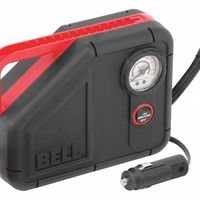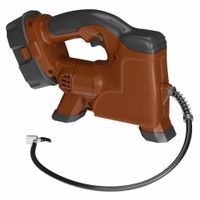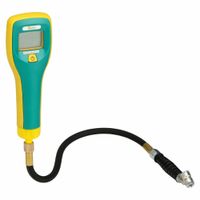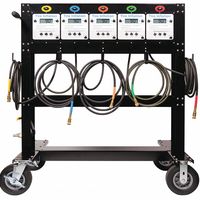Call +(254) 703 030 000 / 751 483 999 / 721 704 777
- Home
- Fleet Vehicle Maintenance
- Tire Brake Maintenance
- Tire Repair
- Tire Inflator Deflator Equipment
Tire Inflator & Deflator Equipment
Tire inflators and deflators fill or release air from tires to achieve the correct pressure levels. Cordless tool inflators do not require a power source to supply pressurized air for filling tires on cars, light trucks, and compact equipment. 12V tire inflators plug into a vehicle's accessory power .....Read More
Frequently Asked Questions
What is the best tire inflator for cars?
The best tire inflator for cars is the Viair 88P Portable Air Compressor. It offers a balance of performance, reliability, and convenience, making it a top choice for many car owners. The Viair 88P is powered by a direct connection to a car battery, providing a maximum working pressure of 120 PSI, which is suitable for most passenger vehicles. It features a 12-foot air hose and a 10-foot power cord, allowing easy access to all tires. The inflator is equipped with an LED power indicator, a solid brass twist-on tire chuck, and a 3-piece inflation tip kit, enhancing its versatility.
The Viair 88P is known for its durability, with a robust build that can withstand regular use. It operates relatively quietly compared to other models, and its compact size makes it easy to store in a vehicle. The inflator's ability to inflate a standard car tire from 0 to 30 PSI in about 3 minutes is efficient, saving time during emergencies.
Additionally, the Viair 88P's user-friendly design includes a built-in pressure gauge, allowing users to monitor tire pressure accurately during inflation. This feature helps prevent over-inflation, ensuring safety and optimal tire performance. While it may be slightly more expensive than some basic models, its reliability and performance justify the investment.
Overall, the Viair 88P Portable Air Compressor is a well-rounded choice for car owners seeking a dependable and efficient tire inflator. Its combination of power, ease of use, and durability makes it a standout option in the market.
How do cordless tire inflators work?
Cordless tire inflators operate using a rechargeable battery to power a small air compressor. When activated, the inflator draws in ambient air through an intake valve. The air is then compressed by a piston or diaphragm mechanism driven by an electric motor. This compressed air is directed through a hose to the tire valve, inflating the tire.
The inflator typically features a digital or analog pressure gauge to monitor the tire's pressure. Users can set a desired pressure level, and the device will automatically shut off once this level is reached, preventing over-inflation. Many models also include LED lights for visibility in low-light conditions and various nozzle attachments for inflating different items.
The portability and convenience of cordless tire inflators make them ideal for emergency situations and regular maintenance, as they eliminate the need for a power outlet or external air source.
Can a 12V tire inflator be used for truck tires?
It depends on the specific tire inflator and the type of truck tires. Most 12V tire inflators are designed for passenger vehicles and may not be suitable for larger truck tires, especially those on heavy-duty trucks. These inflators typically have lower maximum pressure and airflow rates, which may not be sufficient for the higher pressure requirements of truck tires.
For light trucks or smaller commercial vehicles with tire pressure requirements similar to passenger cars, a 12V inflator might work if it has a high enough maximum pressure rating, usually around 100-150 PSI. However, it may take longer to inflate larger tires due to lower airflow rates.
For heavy-duty trucks, which often require pressures exceeding 100 PSI and have larger volume tires, a more powerful inflator or an air compressor designed for high-pressure applications is recommended. These devices are typically powered by a 120V AC outlet or a vehicle's onboard air system.
Always check the specifications of the tire inflator, including its maximum pressure and airflow rate, and compare them to the requirements of the truck tires. Additionally, ensure the inflator has the appropriate connectors and is capable of handling the tire's volume and pressure needs.
How long does it take to inflate a tire with a portable inflator?
The time it takes to inflate a tire with a portable inflator can vary based on several factors, including the type and power of the inflator, the size of the tire, and the initial pressure of the tire. Generally, a portable inflator can take anywhere from 3 to 10 minutes to inflate a standard car tire from flat to the recommended pressure, which is typically around 30-35 PSI.
1. **Type and Power of Inflator**: Portable inflators come in various types, such as electric, battery-operated, or manual. Electric inflators, especially those that plug into a car's 12V outlet, are usually faster and more efficient, taking about 3 to 8 minutes. Battery-operated inflators might take slightly longer, while manual pumps can take significantly more time and effort.
2. **Tire Size**: Larger tires, such as those on trucks or SUVs, will take longer to inflate compared to smaller car tires. For instance, inflating a truck tire might take 8 to 15 minutes, depending on the inflator's capacity.
3. **Initial Pressure**: If the tire is completely flat, it will take longer to reach the desired pressure compared to a tire that is only slightly under-inflated. Starting from a higher initial pressure reduces the time needed.
4. **Inflator Features**: Some inflators come with features like automatic shut-off, which stops the inflation process once the desired pressure is reached, ensuring efficiency and preventing over-inflation.
In summary, while a portable inflator can typically inflate a standard car tire in about 3 to 10 minutes, the exact time depends on the inflator's power, tire size, and initial pressure.
Are tire inflators accurate in measuring pressure?
Tire inflators can vary in accuracy when measuring pressure, depending on several factors such as the quality of the device, calibration, and usage conditions. High-quality tire inflators from reputable manufacturers tend to have more accurate pressure gauges. These devices often come with digital displays that provide precise readings, usually within a margin of error of 1-2 PSI (pounds per square inch).
However, lower-end or poorly maintained inflators may not be as reliable. Mechanical gauges, which are common in cheaper models, can be less accurate due to wear and tear or manufacturing inconsistencies. Additionally, the accuracy of any tire inflator can be affected by temperature fluctuations, altitude changes, and user error, such as improper attachment to the tire valve.
Regular calibration is crucial for maintaining accuracy. Over time, even high-quality inflators can drift from their original calibration, leading to inaccurate readings. Users should periodically check their inflator's accuracy against a known standard or have it professionally calibrated.
For the most reliable results, it's advisable to use a separate, high-quality tire pressure gauge to verify the readings from a tire inflator. This is especially important for critical applications, such as in racing or heavy-duty vehicles, where precise tire pressure is essential for performance and safety.
In summary, while tire inflators can be accurate, their reliability depends on the quality of the device, regular maintenance, and proper usage. For critical applications, cross-verifying with a dedicated pressure gauge is recommended.
What is the difference between a tire inflator and a compressor?
A tire inflator and a compressor both serve the purpose of supplying air, but they differ in design, functionality, and application.
A tire inflator is a compact, portable device specifically designed for inflating tires. It typically operates on a 12V power source, such as a car's cigarette lighter socket, and is equipped with a pressure gauge to monitor tire pressure. Tire inflators are lightweight, easy to use, and often come with preset pressure settings for convenience. They are ideal for emergency situations and quick top-ups, but they generally have lower air output and are not suitable for heavy-duty tasks.
On the other hand, a compressor is a more versatile and powerful machine that can be used for a variety of applications beyond inflating tires. Compressors come in various sizes and capacities, ranging from small portable units to large industrial machines. They can be powered by electricity, gasoline, or diesel. Compressors work by converting power into potential energy stored in pressurized air, which can then be used to power pneumatic tools, spray paint, or inflate large objects. They have higher air output and can maintain continuous airflow, making them suitable for demanding tasks.
In summary, the main differences lie in their size, power, and versatility. Tire inflators are portable and convenient for tire inflation, while compressors are more powerful and versatile, suitable for a wide range of applications.
How do I choose the right tire inflator for my needs?
1. **Purpose and Usage**: Determine if you need the inflator for regular car tires, bicycles, sports equipment, or heavy-duty vehicles. This will guide the required power and features.
2. **Power Source**: Choose between corded (AC), cordless (battery-operated), or car-powered (DC) inflators. Corded models are powerful but less portable, while cordless ones offer flexibility. Car-powered inflators are convenient for on-the-go use.
3. **Pressure Rating**: Check the maximum PSI (pounds per square inch) the inflator can handle. Ensure it meets or exceeds the requirements of your tires.
4. **Inflation Speed**: Look for the CFM (cubic feet per minute) rating, which indicates how quickly the inflator can fill a tire. Higher CFM means faster inflation.
5. **Size and Portability**: Consider the size and weight if you need to carry it in your vehicle. Compact models are easier to store and transport.
6. **Features**: Look for features like automatic shut-off, digital pressure gauge, LED lights for night use, and multiple nozzle attachments for versatility.
7. **Durability and Build Quality**: Choose a model with a sturdy build, especially if you plan to use it frequently or in rugged conditions.
8. **Noise Level**: Some inflators can be quite loud. If noise is a concern, look for models specifically designed to operate quietly.
9. **Price and Warranty**: Set a budget and compare models within that range. Check for warranty options to ensure long-term reliability.
10. **Brand Reputation and Reviews**: Research brands known for quality and read customer reviews to gauge performance and reliability.
11. **Ease of Use**: Ensure the inflator is user-friendly, with clear instructions and easy-to-read displays.



